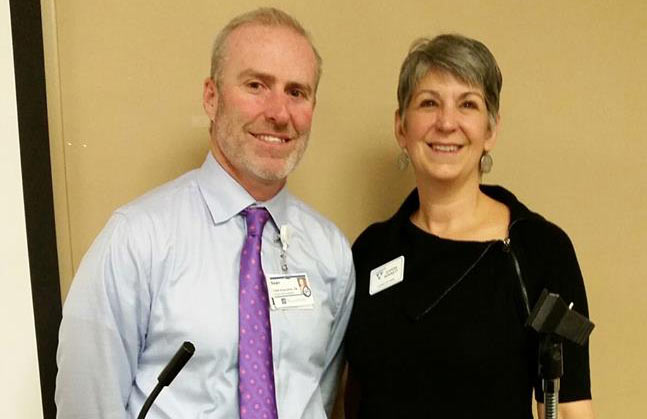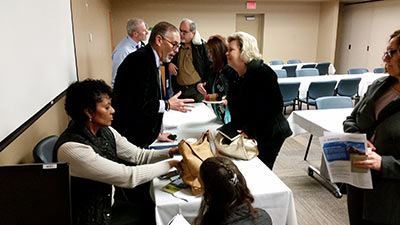
On November 16, Leadership Clark County (LCC) hosted a discussion about community health at the PeaceHealth Southwest education center as part of its Leadership Speaker Series. The event was organized by LCC Executive Director Sherrie Jones and Workforce Southwest Washington CEO Jeanne Bennett.
There were four guest panelists: Vanessa Gaston, director, Clark County Community Services; Dr. Alan Melnick, Public Health director and Clark County Health officer; Sean Gregory, chief executive, Columbia Network, PeaceHealth; and Barbe West, executive director, Southwest Washington Accountable Community Health. Bennett was also the special guest emcee, leading the panel with questions.
The event aimed to answer a variety of questions surrounding community health. Some of those questions included:
What determines the amount of health in a community?
“The World Health Organization (WHO) definition is ‘a state of complete physical, mental and social well-being and not merely the absence of disease or infirmity,’” Melnick said. “There are social determinants: access to housing, exercise, good food, a trauma-free childhood, and racism or gender-bias.”
Gaston said what determines the amount of health consists of the vulnerable and disabled people in the community, people with few resources and little voice – basic needs to be able to live.
“The solution shouldn’t rely on charity,” Gaston said. “She and her organization are there to fight for the systems and resources to help them thrive.”
“As a volunteer at a health care facility, I saw people coming and going, coming back and going,” West said. “I think we should go even further upstream to keep the community healthier – jobs, education, and affordable housing.”
At PeaceHealth, Gregory said they are motivated and prepared to get people through their life’s worst crisis.
“It’s the beauty of modern medicine and how we can help the body – its shape, energy-level,” he said.
What role should we play in creating better community health?
“PeaceHealth ranges from Florence, Ore., to Ketchikan, Alaska – we’re vested in the community’s health,” Gregory said. “The concerns are affordable housing, food scarcity and access. For community health, it’s often getting people together to find funding. I see our role as facilitators to bring people together. We’re the largest health care provider in Clark County.”
“In Southwest Washington, we are one of nine Accountable Communities of Health (ACH) (nonprofits to improve health in the local community),” West said. “We had received a five-year Medicaid Transformation fund, to bring communities together for health care and to think about how to effectively provide care to the Medicaid population. Currently we’re developing multi-year plans about how we can bring about change. The first of the year, we’ll announce what the plans are going forward.”
Melnick said that we need to create the conditions for health in the community – “the three Ps – Protect, Promote and Prevent.”

“We need to look at the system as a whole, and uncover the gaps in services,” Gaston said.
How do we measure how healthy the community is?
Gregory said that something they look at is what people die from – the death certificate – and the conditions associated with birth. They get morbidity data from partners, which includes injuries, and behaviors, and self-reported health.
“The federal government requires that we do needs assessment, so that programs are meeting needs,” Gaston said. “The state comes with lots of outcomes, performance outcomes. We need to help people get into shelters and then out to housing, and to fund food banks. It helps us target our resources if we’re partnering within the community to do needs assessments.”
Money and funding – how and what challenges?
“Strings came with the money – you must follow the guidelines – from Federal and state government,” Gaston said. “We asked for flexibility, and then pieced together shoe-string budgets. But anyone would have to be in real crisis or they’re not eligible.”
“There’s not a lot of advocacy for substance abuse or mental health issues, especially with the stigma associated with that,” Melnick said.
“The Transformation meant changes for providers – a decrease in payment of 5 to 6 percent, and a shift from community funding to public funding,” Gregory said. “This puts pressure on productivity. It requires that we become more creative to find solutions – how to make this work in the new paradigm.”
With the social determinants, if you could have one dream, one solution, what would you have?
“More investment in a variety of affordable housing, with services more connected to housing, creating a community,” Gaston said. “In a Tacoma housing site, there’s a clinic in the middle, and a community garden and grocery stores, bus stops, and classes to teach about health, and a school up the street. They built a community. We’ll see the positive side downstream, but some people are impatient with this.”
“It’s multi-generational,” Melnick said. “We’ll see the outcomes in 10, 20 years. Right now there are food deserts, food swamps, where there are only unhealthy foods.”
“Eliminate silos and lack of funding,” West said. “Focus on full person care.”
“We struggle with the sandwich generation,” Gregory said. “The fastest growing disease is memory diseases. Adult children struggle with how to care for mom and dad, and still do for their own family. It’s a challenge. One example was a man sitting in a chair at a hospital. Several weeks later, I saw this same man. The son couldn’t take care of both his father and his kids.”
“Florida has a community for people in my age range, so they can keep you in the community, not in nursing homes,” Gaston said. “There are 150,000 people in that community. Here, we’re not planning for that. The Land Use Laws – we’re not thinking that way in Washington state.”



